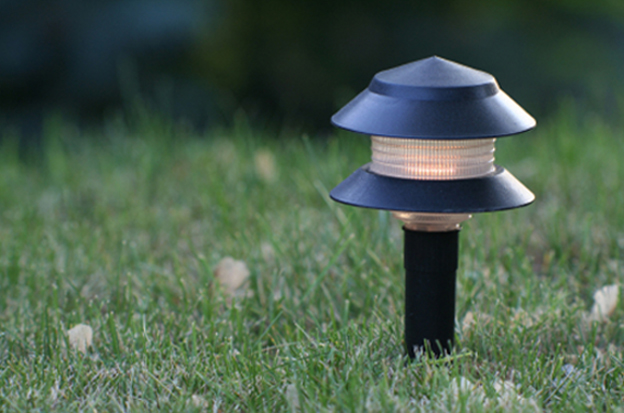Outdoor Lighting Techniques
Lighting, whether indoor or outdoor, is typically classified as ambient, task, or accent lighting. Ambient, or what is commonly referred to as general, lighting illuminates a large area. Task lighting provides light that is concentrated in a small area for a specific purpose, and accent lighting directs your eye to an element of decoration, highlighting the element and imposing a more dramatic scene. Depending on what you want to achieve with your outdoor lighting, you might incorporate one or all of the above kinds of lighting by using various lighting techniques.
Lighting techniques are methods of applying light, from one fixture or multiple fixtures, to specific elements or areas, to achieve a desired effect. Three basic techniques are used in outdoor lighting: downlighting, uplighting, and transverse lighting. Downlighting uses a fixture installed above the element being lit. Uplighting and transverse lighting use fixtures installed at ground level. Uplighting is installed below an element, directing light up, and transverse lighting is installed in front of an element, directing light across the ground. Other techniques are essentially variations of these three basic techniques.
 Spread Lighting uses fixtures installed within landscaping or at fixed locations on walls, ceilings, or posts. Illumination increases visibility in gardens and flower beds and at entries.
Spread Lighting uses fixtures installed within landscaping or at fixed locations on walls, ceilings, or posts. Illumination increases visibility in gardens and flower beds and at entries.- Path Lighting uses multiple fixtures installed along sidewalks or pathways. Downward illumination increases visibility at night, allowing for safe travel along walkways.
- Spot Lighting uses fixtures installed in front of elements and accentuates architectural details or the texture of landscaping.
- Cross Lighting uses multiple fixtures installed in front of elements. Illuminating an element from two or more angles plays with light and shadow, creating a dramatic focal point.
- Silhouetting or Back Lighting uses a fixture installed behind a landscape or hardscape element. Illuminating upward accentuates the shape of that landscape or hardscape.
- Shadowing or Side Lighting uses a fixture installed to the side of an element. Illuminating from the side accentuates the structure of a landscape element and allows you to create and position shadows.
- Grazing or Washing uses a fixture installed near the base of a vertical surface. Illuminating upward enhances the texture of a building's facade.
- Moon Lighting uses a fixture installed in the branches of a tree and illuminating downward; this supplies dramatic light that filters through tree branches.
- Tree Lighting uses a fixture installed at the base of a tree. Illuminating upward accentuates the structure and/or highlights the foliage of a tree.
- Pool Lighting uses submersible fixtures installed in various locations within a pool. Illuminating a pool increases visibility, promoting safe swimming at night, and offers dramatic lighting effects, adding to the ambience of an evening.
- Deck Lighting uses fixtures installed in various locations on a deck. Illuminating areas along a deck provides ambient light that warms social gatherings or quiet evenings after the sun has gone down.
- Stair Lighting uses fixtures installed on the risers. Illuminating the steps increases visibility at night, allowing for safe travel up and down the stairs.
- Security or Flood Lighting uses fixtures installed at various locations around the home. Installing a motion detector near doors or windows where an intruder could gain entry to your home or flood lighting areas where an intruder could hide are excellent deterrents against theft and vandalism.
- Task Lighting uses fixtures installed at various locations around the home where a specific activity is performed. Illuminating downward from the top of a basketball hoop, for example, allows the court to be used after the sun has gone down. Another popular spot for task lighting is at the grill, adding hours of use.
Outdoor Lighting Fixtures
Outdoor lighting can be used in virtually any manner around the home. Fixtures are designed and manufactured for specific types of energy and various lighting techniques, and they come in a variety of sizes, styles, and finishes.
Outdoor lighting fixtures are either movable or non-movable. Movable outdoor light fixtures are typically solar-powered stake lights that can be easily taken up and repositioned, while non-movable outdoor light fixtures are hardwired and installed in a specific locations. Non-movable outdoor lighting is either fixed (i.e., the fixture emits a constant light) or adjustable and can be dimmed if desired. Common types of fixtures include wall, ceiling, post, pathway, flood, spot, step, bollard, and yard lights. Specialty types of fixtures include submersible, flag pole, basketball hoop, motion sensor, dusk to dawn, and dark sky friendly lights.
Outdoor Lighting Techniques is an exert from Outdoor Lighting: Technology, Techniques, and Fixtures by Jeff Calcamuggio

Buildipedia Staff
The Buildipedia research and writing staff consists of dozens of experienced professionals from many sectors of the industry, including architects, designers, contractors, and engineers.
Website: buildipedia.com/